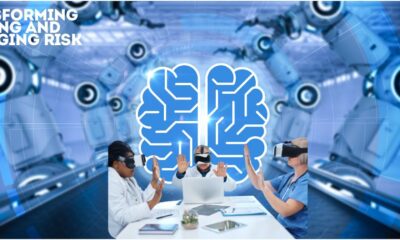Artificial Intelligence
Top 10 AI Innovations Making Business Operations Easier and More Profitable
Published
10 months agoon
Artificial Intelligence (AI) has rapidly evolved from a futuristic concept into a transformative force that is reshaping industries and redefining business operations. Today, AI is not only enhancing the efficiency of day-to-day operations but also driving profitability by enabling businesses to make smarter decisions, optimize processes, and deliver superior customer experiences. This article delves into the top 10 AI innovations that are making business operations easier and more profitable, highlighting the ways in which these technologies are revolutionizing the corporate landscape.
1. AI-Powered Predictive Analytics
Predictive analytics has emerged as one of the most powerful AI-driven tools in business. By analyzing historical data, AI algorithms can predict future trends, customer behaviors, and potential risks, enabling businesses to make more informed decisions.
How It Works
Predictive analytics uses machine learning algorithms to identify patterns and correlations in historical data. These models can then forecast future outcomes, such as sales trends, customer churn, or demand fluctuations. The accuracy of these predictions improves over time as the AI system learns from new data.
For example, in retail, predictive analytics can forecast which products will be in high demand during a particular season, allowing businesses to optimize inventory levels. In finance, it can predict which customers are likely to default on loans, enabling proactive risk management.
Benefits
- Enhanced Decision-Making: Predictive analytics provides businesses with actionable insights, allowing them to anticipate trends and make data-driven decisions.
- Cost Reduction: By predicting demand and optimizing inventory, businesses can reduce waste and minimize holding costs.
- Increased Revenue: Understanding customer behavior enables personalized marketing and sales strategies, leading to higher conversion rates and customer retention.
2. AI-Driven Customer Service Chatbots
Customer service is a critical aspect of any business, and AI-driven chatbots are revolutionizing how companies interact with their customers. These virtual assistants can handle a wide range of customer inquiries, providing instant support and improving overall customer satisfaction.
How It Works
AI chatbots use natural language processing (NLP) to understand and respond to customer queries in real time. These chatbots are integrated into websites, social media platforms, and messaging apps, where they can engage with customers 24/7. Advanced chatbots can handle complex interactions, such as processing orders, resolving complaints, and providing personalized recommendations.
For example, a telecommunications company might use a chatbot to assist customers with troubleshooting issues, checking their account balances, or upgrading their service plans. The chatbot can also escalate more complex issues to a human agent if necessary.
Benefits
- 24/7 Availability: AI chatbots can provide round-the-clock customer support, reducing wait times and ensuring that customers always have access to assistance.
- Cost Efficiency: By automating routine customer service tasks, businesses can reduce the need for large customer support teams, cutting operational costs.
- Improved Customer Satisfaction: Instant responses and personalized interactions lead to higher customer satisfaction and loyalty.
3. Robotic Process Automation (RPA)
Robotic Process Automation (RPA) is a game-changer for businesses looking to streamline operations and reduce manual workloads. RPA uses AI to automate repetitive, rule-based tasks, freeing up employees to focus on more strategic activities.
How It Works
RPA involves the use of software robots (bots) to perform tasks that are typically carried out by humans, such as data entry, invoice processing, and customer onboarding. These bots can interact with various applications, follow predefined workflows, and complete tasks with high accuracy and speed.
For example, an insurance company might use RPA to automate the processing of claims, from data extraction and validation to payment disbursement. This not only speeds up the claims process but also reduces errors and operational costs.
Benefits
- Increased Efficiency: RPA bots can perform tasks faster and more accurately than humans, leading to significant time savings and higher productivity.
- Cost Savings: Automating routine tasks reduces the need for manual labor, lowering operational costs and increasing profitability.
- Scalability: RPA solutions can be easily scaled to handle increased workloads, making them ideal for growing businesses.
4. AI-Powered Supply Chain Optimization
Supply chain management is a complex process that involves coordinating multiple elements, from procurement and manufacturing to distribution and logistics. AI-powered solutions are transforming supply chain operations by improving visibility, reducing costs, and enhancing decision-making.
How It Works
AI in supply chain optimization involves the use of machine learning algorithms to analyze data from various sources, such as suppliers, warehouses, and transportation networks. These algorithms can identify inefficiencies, predict demand, and optimize inventory levels. AI can also automate tasks such as demand forecasting, route planning, and supplier selection.
For example, a manufacturing company might use AI to predict demand for its products based on historical sales data, market trends, and external factors like weather patterns. The AI system can then optimize inventory levels, reducing excess stock and minimizing the risk of stockouts.
Benefits
- Improved Demand Forecasting: AI provides more accurate demand forecasts, enabling businesses to optimize inventory levels and reduce carrying costs.
- Enhanced Decision-Making: AI-driven insights help businesses make better decisions regarding supplier selection, production scheduling, and logistics planning.
- Cost Reduction: By optimizing the supply chain, businesses can reduce waste, lower transportation costs, and improve overall efficiency.
5. AI-Powered Marketing Automation
Marketing is a crucial function for any business, and AI-powered marketing automation is helping companies deliver personalized, data-driven campaigns with greater efficiency. These tools can automate everything from email marketing and social media management to lead scoring and customer segmentation.
How It Works
AI-driven marketing automation platforms use machine learning to analyze customer data and behavior. They can segment audiences, personalize content, and optimize campaign timing. For instance, an AI system might analyze a customer’s past interactions with a brand to determine the best time to send a promotional email or the type of content that is most likely to resonate with them.
These platforms can also track the performance of marketing campaigns in real time, allowing businesses to make adjustments on the fly to maximize ROI. Additionally, AI can automate A/B testing, enabling marketers to quickly identify the most effective strategies.
Benefits
- Personalized Marketing: AI enables businesses to deliver highly personalized content to each customer, increasing engagement and conversion rates.
- Efficiency: Marketing automation reduces the time and effort required to manage campaigns, allowing marketers to focus on strategy and creativity.
- Data-Driven Insights: AI provides valuable insights into customer behavior and campaign performance, enabling continuous optimization.
6. AI-Powered Fraud Detection
As businesses increasingly move online, the risk of fraud has grown. AI-powered fraud detection systems are essential for protecting businesses from financial losses and safeguarding customer trust. These systems can identify and prevent fraudulent activities in real time, reducing the impact of fraud on businesses.
How It Works
AI-driven fraud detection systems use machine learning algorithms to analyze large volumes of transaction data and identify patterns that indicate fraudulent behavior. These systems can detect anomalies, such as unusual spending patterns or multiple transactions from different locations, and flag them for further investigation.
For example, a financial institution might use AI to monitor credit card transactions in real time. If the system detects a transaction that is inconsistent with the cardholder’s typical behavior, it can automatically block the transaction and alert the cardholder.
Benefits
- Real-Time Detection: AI systems can detect and prevent fraudulent activities as they happen, reducing the financial impact on businesses.
- Accuracy: Machine learning models continuously learn from new data, improving their ability to identify fraud and reducing false positives.
- Cost Savings: By preventing fraud, businesses can avoid significant financial losses and reduce the costs associated with fraud investigations.
7. AI-Driven Workforce Management
Managing a workforce is a complex task that involves scheduling, performance management, and employee engagement. AI-driven workforce management tools are making it easier for businesses to optimize their human resources, ensuring that the right people are in the right place at the right time.
How It Works
AI-powered workforce management systems use machine learning to analyze employee data, such as work schedules, performance metrics, and attendance records. These systems can optimize shift scheduling, predict staffing needs, and identify patterns that indicate employee disengagement or turnover risk.
For example, a retail chain might use AI to predict peak shopping times and ensure that enough staff are scheduled to meet customer demand. The system can also identify employees who may need additional training or support based on their performance data.
Benefits
- Optimized Scheduling: AI ensures that businesses have the right number of employees scheduled at all times, reducing labor costs and improving customer service.
- Enhanced Employee Engagement: By identifying patterns in employee behavior, AI can help managers address issues before they lead to disengagement or turnover.
- Improved Performance Management: AI-driven insights enable more effective performance reviews and personalized development plans, helping employees reach their full potential.

8. AI-Powered Financial Management
Financial management is a critical aspect of any business, and AI is revolutionizing the way companies manage their finances. AI-powered financial management tools can automate accounting tasks, optimize cash flow, and provide real-time financial insights, making it easier for businesses to stay on top of their finances.
How It Works
AI in financial management involves the use of machine learning algorithms to analyze financial data, such as revenue, expenses, and cash flow. These tools can automate tasks such as invoicing, expense tracking, and payroll processing. They can also provide real-time financial insights, such as cash flow forecasts and profitability analysis.
For example, an AI-powered accounting platform might automatically categorize expenses, reconcile bank transactions, and generate financial reports. The system can also alert business owners to potential cash flow issues and suggest ways to optimize spending.
Benefits
- Time Savings: AI automates routine financial tasks, freeing up time for business owners and finance teams to focus on strategic planning.
- Improved Cash Flow Management: AI-driven insights help businesses optimize cash flow, ensuring that they have enough liquidity to meet their obligations.
- Real-Time Financial Insights: AI provides businesses with up-to-date financial information, enabling better decision-making and financial planning.
9. AI-Driven Product Recommendations
Personalization is key to driving sales, and AI-driven product recommendation engines are helping businesses deliver personalized shopping experiences. These systems analyze customer data to suggest products that are most likely to appeal to individual shoppers, increasing sales and customer satisfaction.
How It Works
AI-powered recommendation engines use machine learning algorithms to analyze customer behavior, such as browsing history, purchase history, and search queries. Based on this data, the system predicts which products the customer is most likely to be interested in and displays these recommendations.
For example, an e-commerce platform might use AI to recommend products to customers based on their past purchases and browsing history. The system can also use collaborative filtering to recommend products that similar customers have bought.
Benefits
- Increased Sales: Personalized product recommendations lead to higher conversion rates and average order values, boosting revenue.
- Enhanced Customer Experience: AI-driven recommendations create a more personalized shopping experience, improving customer satisfaction and loyalty.
- Reduced Cart Abandonment: By suggesting relevant products, AI can help reduce cart abandonment rates and encourage customers to complete their purchases.
10. AI-Driven Inventory Management
Effective inventory management is essential for maintaining profitability, and AI-driven solutions are making it easier for businesses to optimize their stock levels. These systems use AI to predict demand, manage stock levels, and reduce the risk of overstocking or stockouts.
How It Works
AI-powered inventory management systems analyze data from sales, customer orders, and market trends to predict future demand. These systems can automatically adjust inventory levels, reorder stock, and optimize warehouse operations. AI can also identify slow-moving products and suggest strategies for reducing excess inventory.
For example, a retailer might use AI to forecast demand for seasonal products, ensuring that they have enough stock to meet customer demand without overstocking. The system can also track inventory levels in real-time, automatically placing orders with suppliers when stock levels fall below a certain threshold.
Benefits
- Optimized Stock Levels: AI ensures that businesses maintain the right inventory levels, reducing the risk of overstocking or stockouts.
- Cost Savings: By optimizing inventory management, businesses can reduce carrying costs, minimize waste, and improve cash flow.
- Improved Customer Satisfaction: With the right products in stock at the right time, businesses can meet customer demand and reduce the risk of lost sales.
Conclusion
Artificial Intelligence is revolutionizing business operations across industries, making processes more efficient, reducing costs, and driving profitability. From predictive analytics and customer service chatbots to supply chain optimization and financial management, AI innovations are helping businesses operate smarter and more effectively.
As AI technology continues to evolve, its impact on business operations will only grow. Companies that embrace these AI-driven innovations will be better positioned to compete in an increasingly complex and fast-paced market. By leveraging AI to optimize processes, enhance decision-making, and deliver personalized customer experiences, businesses can unlock new levels of efficiency and profitability, ensuring their success in the digital age.
You may like
-


Unlock Your Creativity with Skillshare: The Ultimate Guide to Online Learning
-


How AI and Machine Learning Are Revolutionizing Every Industry
-
Brand Reputation Management in a Digital World
-


Blockchain Enterprise Applications Changing Business
-


Artificial Intelligence Ethics: Balancing Innovation with Responsibility
-


AI-Powered Robots: Revolutionising the Workforce
-


AI-Enhanced Marketing Tools for Smarter Campaigns
-


AI-Driven Financial Services: The Future of Banking
-


AI-Based Medical Diagnostics: Revolutionising Healthcare
-


Top AI Software Development Tools to Watch

How Managed IT Solutions Help Small Teams Compete at Enterprise Scale

Why Alaxio (ALX) Is a Top Pick for Smart Crypto Investors

Bellarium ($BEL) Price Prediction: Could It Hit $5 by 2026?

Crypto WINNAZ Launches First On-Chain Yield Engine for Meme Coins, Enabling 20x–300x Returns

What to Know Before Switching Cell Phone Network Services in 2025

Global Compound Feeds and Additives Industry Report: Market Expansion and Competitive Insights to 2035

Nura Labs Files Revolutionary Patent: AI-Powered Wallet Solves the $180 Billion Crypto Staking Complexity Crisis

In2space Launches Campaign to Make Space Travel Accessible for All

Inside Schedule F: Will Trump’s Federal Workforce Shake-Up Undermine Democracy?

US Stock Market Soars in May Amidst Tariff Tensions and Inflation Worries

S&P 500 Soars in Best May in Decades Amid Tariff Relief and Nvidia’s Surge

Trump’s Immigration Crackdown: Legal Battles and Policy Shifts

Trump’s Tariffs: A Global Economic Reckoning

Trump Administration’s Government Reshaping Efforts Face Criticism and Legal Battles

Attention Economy Arms Race: Reclaim Your Focus in a World Designed to Distract You
Trending News
-

 Press Release6 days ago
Press Release6 days agoGlobal Compound Feeds and Additives Industry Report: Market Expansion and Competitive Insights to 2035
-

 Technology6 days ago
Technology6 days agoWhat to Know Before Switching Cell Phone Network Services in 2025
-

 Press Release4 days ago
Press Release4 days agoCrypto WINNAZ Launches First On-Chain Yield Engine for Meme Coins, Enabling 20x–300x Returns
-

 Press Release1 day ago
Press Release1 day agoBellarium ($BEL) Price Prediction: Could It Hit $5 by 2026?
-

 Press Release1 day ago
Press Release1 day agoWhy Alaxio (ALX) Is a Top Pick for Smart Crypto Investors
-

 Business15 hours ago
Business15 hours agoHow Managed IT Solutions Help Small Teams Compete at Enterprise Scale



